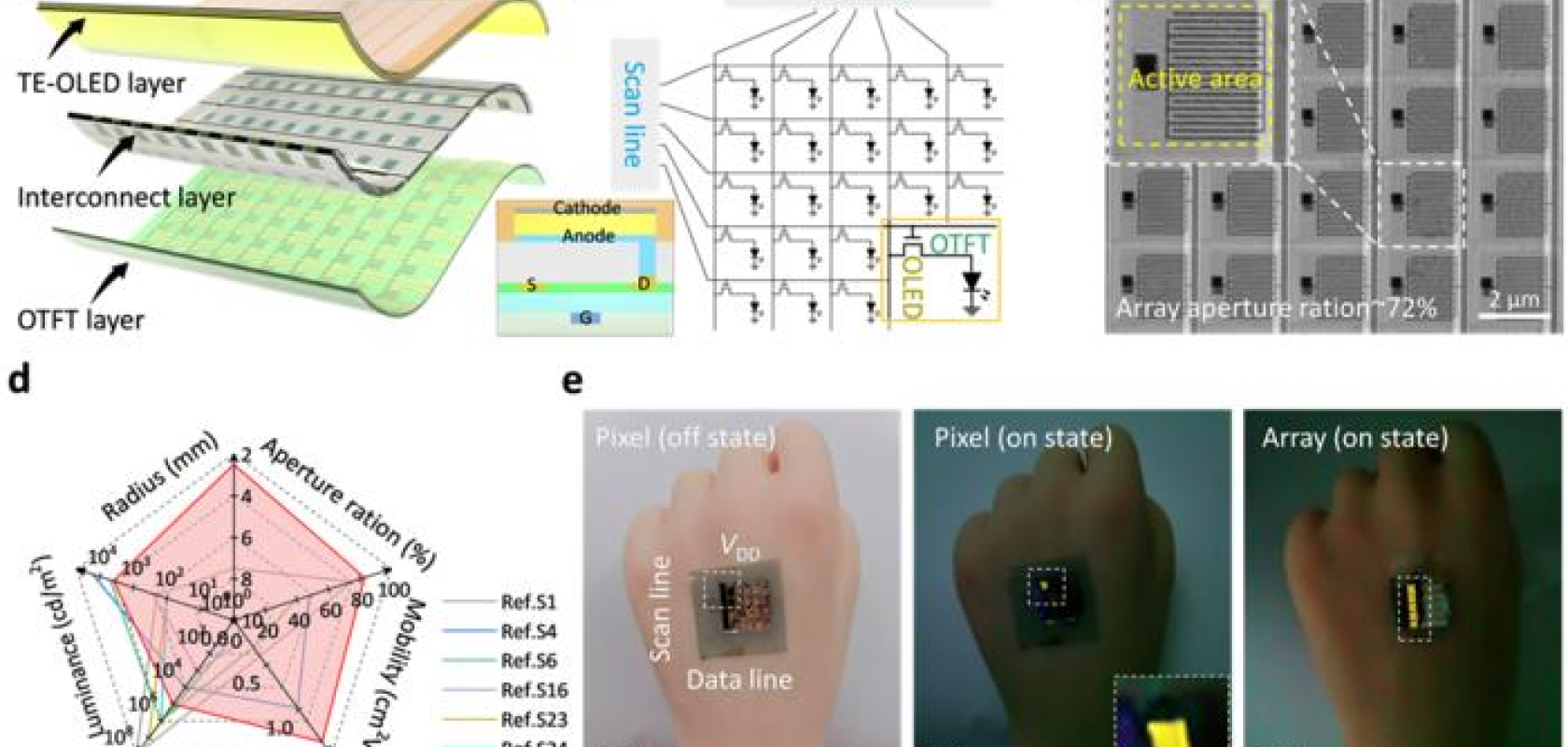A new approach to producing skin-like active-matrix displays via vertical stacking – whereby organic thin-film transistors (OTFTs) and OLEDs are stacked on top of one another, rather than side-by-side, to maximise the active area – overcomes technical challenges to enable high-quality and scalable devices.
The new method involves preparing each conformable functional layer (OLED/interconnection layer/OTFT) separately and then laminating them together, which avoids chemical and physical damage and ensures mechanical compatibility and interconnection between each functional layer.
Fabricating vertically structured skin-like AMOLEDs is complex
Skin-like displays are critical components of information output in next-generation portable and wearable electronics.
Currently, all such displays are fabricated on glass or thick plastic substrates, limiting the inherent mechanical flexibility of organic materials and preventing intimate skin contact. Developing active-matrix (AM) displays comprising organic thin-film transistors (OTFTs) and organic light-emitting diodes (OLEDs) is crucial for achieving high-quality skin-like displays.
Almost all reported AMOLED displays are parallel structures consisting of side-by-side OTFTs and OLED. However, this parallel structure covers part of the pixel area by nonluminous OTFTs and wiring, resulting in low active area, luminance, resolution, and aperture ratio.
Vertically stacking OLEDs and OTFTs eliminates obstruction from nonluminous OTFTs and wiring parts, maximising the active area. In addition, a vertically structured pixel minimises the occupied area, dramatically improving the display’s resolution and quality. Nevertheless, fabricating vertically structured skin-like AMOLEDs is complex because such displays introduce new challenges, including mutual dissolution, mechanical compatibility, and interconnection between functional layers.
Discrete preparation-multilayer lamination
Researchers from the Changchun Institute of Optics, Fine Mechanics and Physics in China have proposed a new strategy of ‘discrete preparation-multilayer lamination’ for the first demonstration of vertically stacked skin-like active-matrix displays.
This method involves separately preparing each conformable functional layer (OLED/interconnection layer/OTFT), and then laminating them together, which effectively avoids chemical and physical damage and ensures mechanical compatibility and interconnection between functional layers.
The team’s experiments introduced no solvents or water during the peeling process, and no additional adhesives were used during the lamination process. The all-dry fabrication avoids mutual dissolution and interface pollution, providing a clean, complete contact interface for fabricating high-quality vertically stacked skin-like displays.
Compared with existing active-matrix display fabrication strategies, the proposed strategy also significantly improves the aperture ratio. By linking the interconnect layer, the OLED array becomes intimately and vertically stacked on an all-photolithographic OTFT array, which results in a complete array with no deletions or cracks.
According to a paper recently published in Light: Science and Applications, the resulting aperture ratio of a pixel is as high as 83%, and the aperture ratio of the display array reaches 71%, both of which surpass the results of all previously reported flexible AMOLED displays.
Unlike conventional layer-by-layer deposition techniques, the new method eliminates chemical (i.e., various solvents) or physical (i.e., etching and heating) damage to fragile organic materials during fabrication, which is essential for fabricating reproducible, high-quality vertically stacked skin-like displays.
In addition, this strategy can integrate modern microelectronic techniques such as photolithography and etching into the skin display, the researchers say, allowing mass production of highly-integrated, high-resolution skin-like displays.
Lastly, in contrast with the layer-by-layer preparation on rigid or flexible substrates, all functional layers are stripped from rigid substrates, liberating them from any mechanical limitations imposed by these substrates. Thus, the proposed display has outstanding mechanical flexibility and good conformability.


